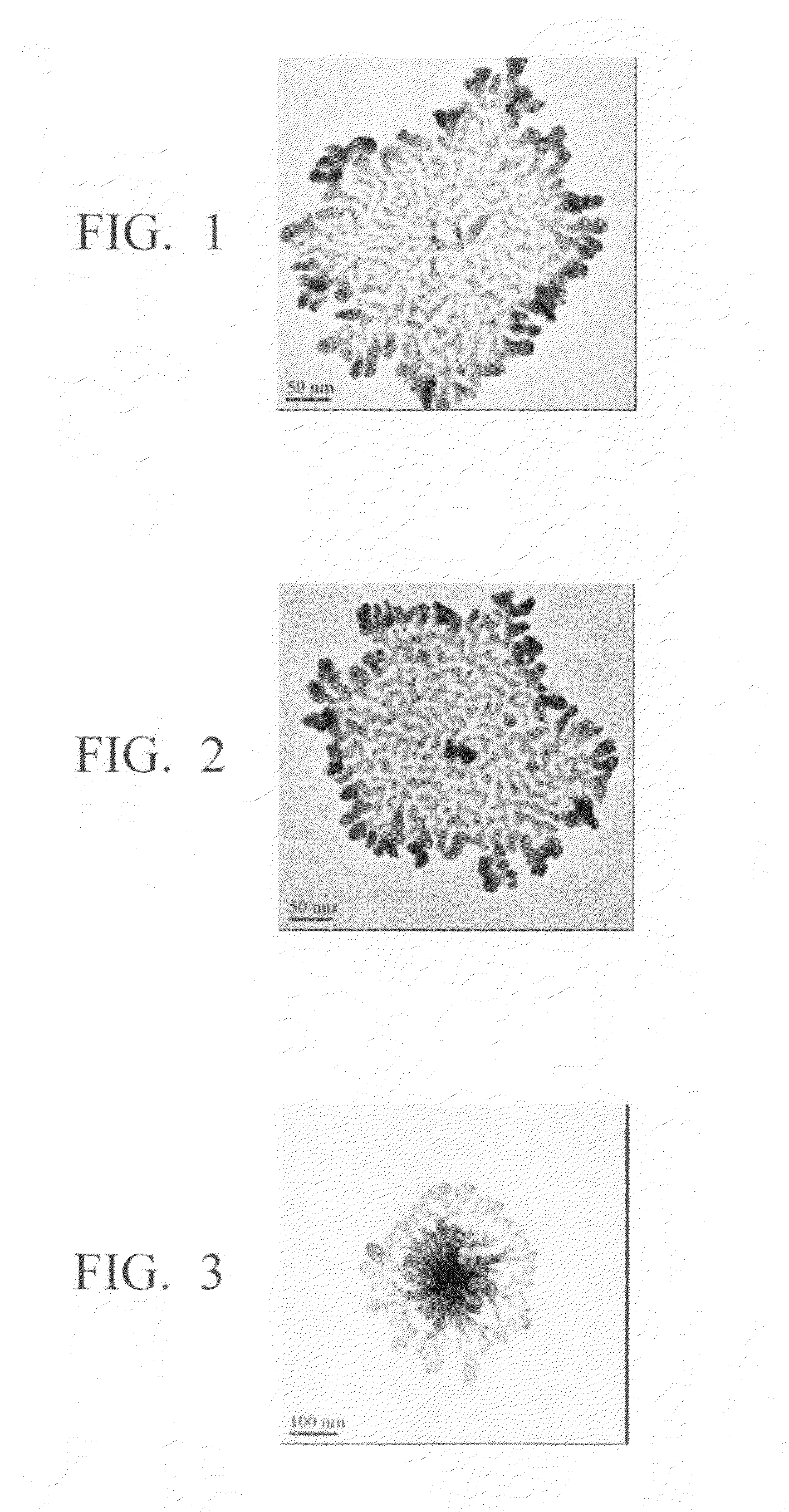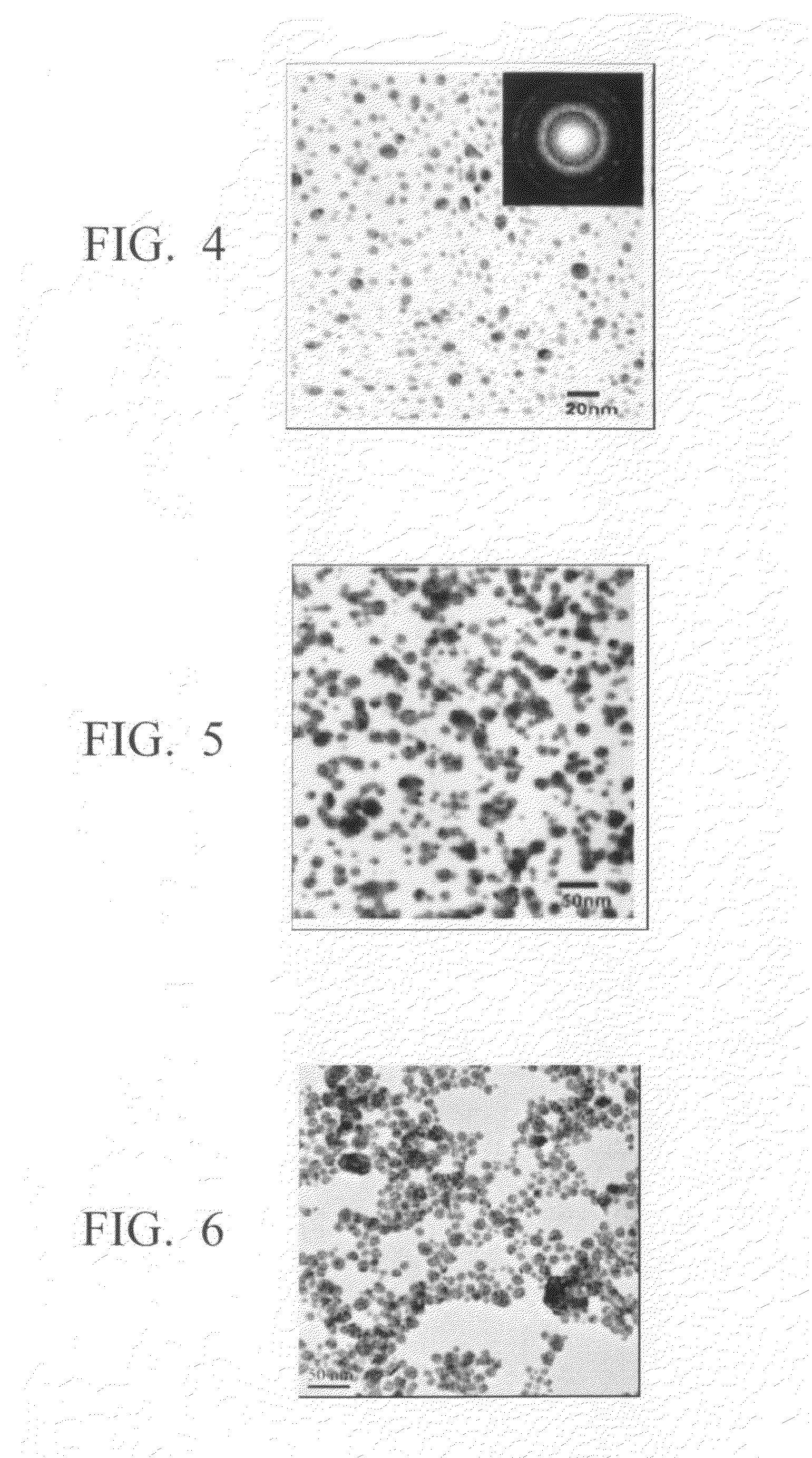Method for production of silver-containing nano-structure, and silver-containing nano-structure
a nano-structure and nano-structure technology, applied in the field of silver-containing nano-structure and silver-containing nano-structure production, can solve the problems of lowering the melting point at the particle surface, affecting the stability of storage, and metal nanoparticles cannot be protected stably, etc., to achieve easy dispersion and isolation, high reduction capacity, and simple operation
- Summary
- Abstract
- Description
- Claims
- Application Information
AI Technical Summary
Benefits of technology
Problems solved by technology
Method used
Image
Examples
synthesis example 1
of Polymeric Compound
Synthesis of Polymer 1
[0099]A chloroform (30 ml) solution containing 9.6 g (50.0 mmol) of p-toluenesulfonyl chloride was added dropwise to a mixed solution containing 20.0 g (10.0 mmol) of methoxy polyethylene glycol [Mn=2,000], 8.0 g (100 mmol) of pyridine and 20 ml of chloroform over the course of 30 minutes with stirring while cooling with ice in a nitrogen atmosphere. Following completion of the dropwise addition, the resulting solution was further stirred for 4 hours in a water bath at a temperature of 40° C. Following completion of the reaction, 50 ml of chloroform were added to dilute the reaction solution. Subsequently, after sequentially washing with 100 ml of 5% aqueous hydrochloric acid solution, 100 ml of aqueous saturated sodium bicarbonate solution and 100 ml of saturated brine, the resulting solution was dried with magnesium sulfate, filtered and concentrated under reduced pressure. After washing the obtained solid material several times with hexa...
synthesis example 2
of Polymeric Compound
Synthesis of Polymer 2
[0105]18.7 g (20 mEq.) of bisphenol A type epoxy resin (EPICLON AM-040-P manufactured by DIC Corporation, epoxy equivalent: 933), 1.28 g (7.5 mmol) of 4-phenylphenol, 0.26 ml (0.12 mol %) of 65% ethyl acetate triphenyl phosphonium ethanol solution and 50 ml of N,N-dimethylacetamide were allowed to react at 120° C. for 6 hours in a nitrogen atmosphere. After being allowed to cool, the obtained solution was dropwise added to 150 ml of water, and the resulting precipitate was then washed twice with methanol, followed by drying under reduced pressure at 60° C. to obtain a monofunctional epoxy resin. The amount of the obtained reaction product was 19.6 g and the yield thereof was 98%.
[0106]The results of 1H-NMR (manufactured by JEOL Ltd., AL300, 300 MHz) measurement for the obtained monofunctional epoxy resin are shown below.
[0107]Result of 1H-NMR (CDCl3) measurement: δ (ppm): 7.55 to 6.75 (m), 4.40 to 3.90 (m), 3.33 (m), 2.89 (m), 2.73 (m), 1.6...
synthesis example 3
of Polymeric Compound
Synthesis of Polymer 3
[0109]Under a nitrogen stream, 13.0 g (101 mmol) of dibutylamine was dropwise added to 20.1 g (100 mEq) of EPICLON 705 (dipropylene glycol diglycidyl ester manufactured by DIC Corporation, epoxy equivalent: 201) at 70° C. over 30 minutes, and the resulting mixture was then stirred at 90° C. for 7 hours to complete the reaction, thereby yielding a compound having dibutylamino groups at both terminal ends thereof. Subsequently, a mixture of the compound having dibutylamino groups at both terminal ends thereof synthesized above was dropwise added to a mixed solution composed of 19.4 g (100 mmol) of diisocyanate (Takenate 600 manufactured by Mitsui Takeda Chemicals Inc.), 0.04 g (0.1 mmol) of tin octylate and 80 g of chloroform at 40° C. over 30 minutes, and the resulting mixture was then stirred at 50° C. for 5 hours to effect an addition reaction, thereby yielding a urethane compound. Thereafter, 5.7 g (50 mmol) of cyclohexane methanol was dr...
PUM
| Property | Measurement | Unit |
|---|---|---|
| temperature | aaaaa | aaaaa |
| particle size | aaaaa | aaaaa |
| particle size | aaaaa | aaaaa |
Abstract
Description
Claims
Application Information
 Login to View More
Login to View More - R&D
- Intellectual Property
- Life Sciences
- Materials
- Tech Scout
- Unparalleled Data Quality
- Higher Quality Content
- 60% Fewer Hallucinations
Browse by: Latest US Patents, China's latest patents, Technical Efficacy Thesaurus, Application Domain, Technology Topic, Popular Technical Reports.
© 2025 PatSnap. All rights reserved.Legal|Privacy policy|Modern Slavery Act Transparency Statement|Sitemap|About US| Contact US: help@patsnap.com



